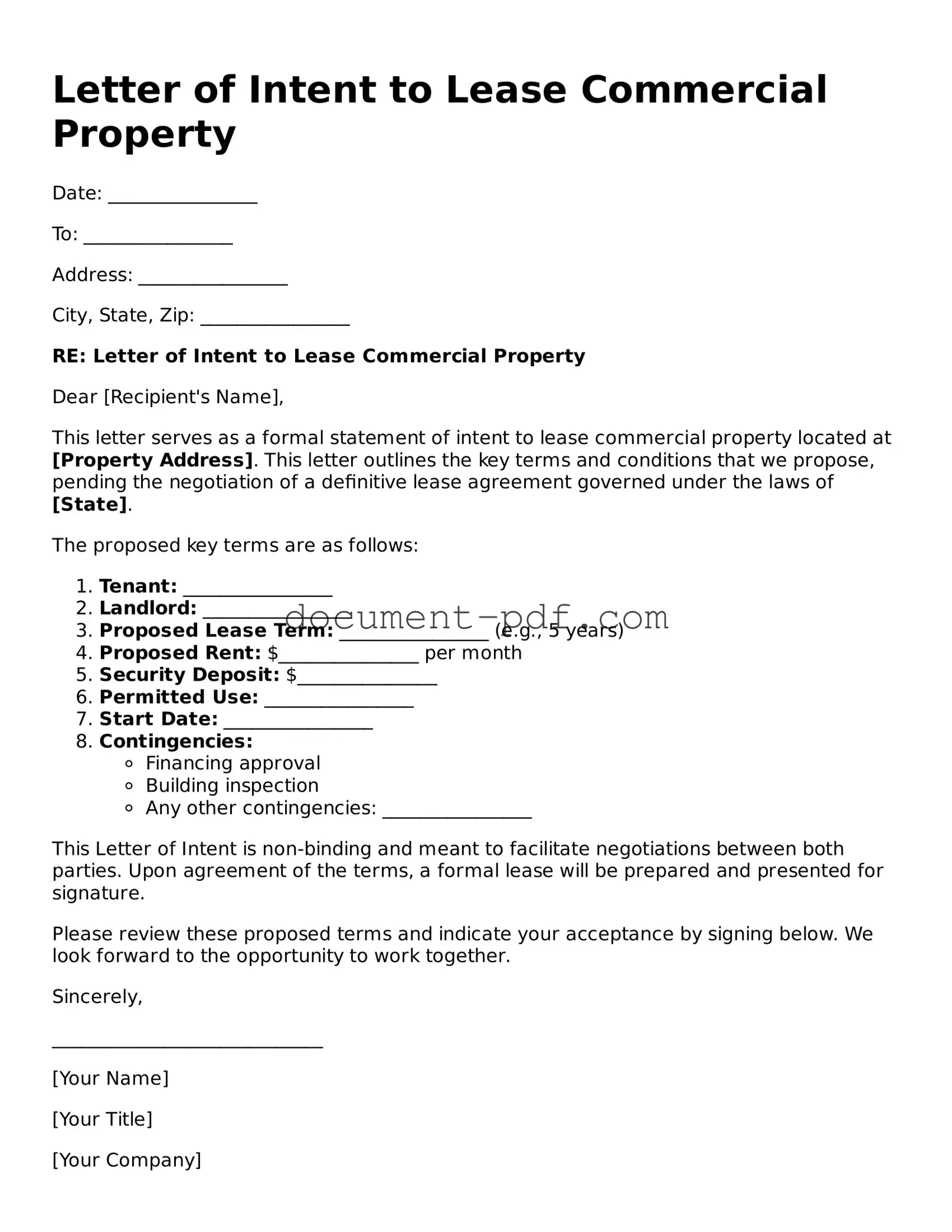The Letter of Intent (LOI) to Lease Commercial Property is similar to a Memorandum of Understanding (MOU). Both documents outline the intentions of the parties involved before finalizing a formal agreement. An MOU serves as a non-binding agreement that clarifies the main points of a potential deal, such as terms and conditions, while the LOI specifically focuses on the leasing aspects of commercial property. Both documents help establish a mutual understanding and can prevent misunderstandings down the line.
Another document akin to the LOI is the Purchase Agreement. While the LOI pertains to leasing, a Purchase Agreement outlines the terms for the sale of real property. Both documents detail critical elements such as price, duration, and responsibilities of the parties involved. However, the Purchase Agreement is legally binding upon acceptance, whereas the LOI generally serves as a preliminary outline of intentions.
The Term Sheet is also similar to the LOI. A Term Sheet summarizes the key terms and conditions of a business deal, whether it involves leasing or purchasing property. Both documents are used to facilitate negotiations by providing a clear framework for discussions. However, a Term Sheet can cover a wider range of topics beyond real estate, including financing and operational aspects, whereas the LOI focuses specifically on leasing terms.
The Non-Binding Letter of Intent shares similarities with the LOI but explicitly states that it does not create any binding obligations. Both documents aim to outline the intentions of the parties and establish a foundation for further negotiations. However, the Non-Binding LOI emphasizes that the parties are not yet committed to any specific terms, allowing for flexibility in discussions.
A Confidentiality Agreement, or Non-Disclosure Agreement (NDA), is another document that often accompanies an LOI. While the LOI outlines the terms of a lease, the NDA protects sensitive information shared during negotiations. Both documents are crucial in commercial transactions, as they ensure that proprietary information remains secure while the parties explore potential agreements.
The Letter of Intent to Purchase Real Estate serves a similar purpose to the LOI for leasing. This document outlines the intentions of a buyer and seller before finalizing a purchase agreement. Both letters convey essential terms such as price, contingencies, and timelines. However, the focus of the Letter of Intent to Purchase is on acquisition rather than leasing, making it a different but related document.
Another comparable document is the Lease Proposal. This document presents a formal offer to lease a property, detailing terms such as rent, duration, and any special conditions. The Lease Proposal, like the LOI, serves to initiate discussions and negotiations. However, it typically includes more specific terms than an LOI, which may still be subject to change.
For parents considering homeschooling their children, understanding the necessary documentation is essential. One important step in this process is submitting a Homeschool Letter of Intent, which formally notifies the school district of your decision to educate your child at home. This directive ensures compliance with state educational regulations, and for more details on how to complete this process effectively, you can visit https://onlinelawdocs.com/california-homeschool-letter-of-intent.
The Business Plan can also be considered similar in that it outlines the strategic goals and operational plans of a business, including potential real estate needs. While the LOI focuses on the leasing aspects, a Business Plan may reference the need for commercial space as part of a broader strategy. Both documents are essential in guiding decision-making and securing necessary resources.
Finally, the Lease Agreement itself is the most formal document related to the LOI. While the LOI serves as a preliminary outline of terms, the Lease Agreement is a legally binding contract that finalizes the lease. Both documents address similar topics such as rent, duration, and responsibilities, but the Lease Agreement provides the detailed legal framework necessary for enforceability.
